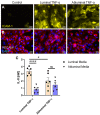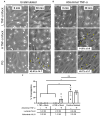Endothelial cell apicobasal polarity coordinates distinct responses to luminally versus abluminally delivered TNF-α in a microvascular mimetic
- PMID: 33164044
- PMCID: PMC7671990
- DOI: 10.1093/intbio/zyaa022
Endothelial cell apicobasal polarity coordinates distinct responses to luminally versus abluminally delivered TNF-α in a microvascular mimetic
Abstract
Endothelial cells (ECs) are an active component of the immune system and interact directly with inflammatory cytokines. While ECs are known to be polarized cells, the potential role of apicobasal polarity in response to inflammatory mediators has been scarcely studied. Acute inflammation is vital in maintaining healthy tissue in response to infection; however, chronic inflammation can lead to the production of systemic inflammatory cytokines and deregulated leukocyte trafficking, even in the absence of a local infection. Elevated levels of cytokines in circulation underlie the pathogenesis of sepsis, the leading cause of intensive care death. Because ECs constitute a key barrier between circulation (luminal interface) and tissue (abluminal interface), we hypothesize that ECs respond differentially to inflammatory challenge originating in the tissue versus circulation as in local and systemic inflammation, respectively. To begin this investigation, we stimulated ECs abluminally and luminally with the inflammatory cytokine tumor necrosis factor alpha (TNF-α) to mimic a key feature of local and systemic inflammation, respectively, in a microvascular mimetic (μSiM-MVM). Polarized IL-8 secretion and polymorphonuclear neutrophil (PMN) transmigration were quantified to characterize the EC response to luminal versus abluminal TNF-α. We observed that ECs uniformly secrete IL-8 in response to abluminal TNF-α and is followed by PMN transmigration. The response to abluminal treatment was coupled with the formation of ICAM-1-rich membrane ruffles on the apical surface of ECs. In contrast, luminally stimulated ECs secreted five times more IL-8 into the luminal compartment than the abluminal compartment and sequestered PMNs on the apical EC surface. Our results identify clear differences in the response of ECs to TNF-α originating from the abluminal versus luminal side of a monolayer for the first time and may provide novel insight into future inflammatory disease intervention strategies.
Keywords: apicobasal polarity; endothelial cells; inflammation; neutrophils; sepsis; tissue-chip.
© The Author(s) 2020. Published by Oxford University Press. All rights reserved. For permissions, please e-mail: journals.permission@oup.com.
Figures







Similar articles
-
Sided Stimulation of Endothelial Cells Modulates Neutrophil Trafficking in an In Vitro Sepsis Model.Adv Healthc Mater. 2024 Aug;13(21):e2304338. doi: 10.1002/adhm.202304338. Epub 2024 Apr 8. Adv Healthc Mater. 2024. PMID: 38547536 Free PMC article.
-
Effect of arginine on cellular adhesion molecule expression and leukocyte transmigration in endothelial cells stimulated by biological fluid from surgical patients.Shock. 2007 Jul;28(1):39-44. doi: 10.1097/shk.0b013e31802f0190. Shock. 2007. PMID: 17483743
-
Loss of endothelial barrier function requires neutrophil adhesion.Surgery. 1997 Aug;122(2):420-6; discussion 426-7. doi: 10.1016/s0039-6060(97)90035-0. Surgery. 1997. PMID: 9288149
-
Cooperation of liver cells in health and disease.Adv Anat Embryol Cell Biol. 2001;161:III-XIII, 1-151. doi: 10.1007/978-3-642-56553-3. Adv Anat Embryol Cell Biol. 2001. PMID: 11729749 Review.
-
Bacterial-induced release of inflammatory mediators by bronchial epithelial cells.Eur Respir J. 1996 Sep;9(9):1913-22. doi: 10.1183/09031936.96.09091913. Eur Respir J. 1996. PMID: 8880112 Review.
Cited by
-
Fluid flow impacts endothelial-monocyte interactions in a model of vascular inflammatory fibrosis.Sci Rep. 2025 Jan 25;15(1):3227. doi: 10.1038/s41598-025-85987-z. Sci Rep. 2025. PMID: 39863621 Free PMC article.
-
A tissue chip with integrated digital immunosensors: In situ brain endothelial barrier cytokine secretion monitoring.Biosens Bioelectron. 2023 Mar 15;224:115030. doi: 10.1016/j.bios.2022.115030. Epub 2022 Dec 24. Biosens Bioelectron. 2023. PMID: 36603283 Free PMC article.
-
The Modular µSiM: A Mass Produced, Rapidly Assembled, and Reconfigurable Platform for the Study of Barrier Tissue Models In Vitro.Adv Healthc Mater. 2022 Sep;11(18):e2200804. doi: 10.1002/adhm.202200804. Epub 2022 Aug 15. Adv Healthc Mater. 2022. PMID: 35899801 Free PMC article.
-
Pericytes Enrich the Basement Membrane and Reduce Neutrophil Transmigration in an In Vitro Model of Peripheral Inflammation at the Blood-Brain Barrier.Biomater Res. 2024 Oct 3;28:0081. doi: 10.34133/bmr.0081. eCollection 2024. Biomater Res. 2024. PMID: 39363889 Free PMC article.
-
Sourcing cells for in vitro models of human vascular barriers of inflammation.Front Med Technol. 2022 Oct 21;4:979768. doi: 10.3389/fmedt.2022.979768. eCollection 2022. Front Med Technol. 2022. PMID: 36483299 Free PMC article. Review.
References
-
- Zeni F, Freeman B, Natanson C. Anti-inflammatory therapies to treat sepsis and septic shock: a reassessment. Crit Care Med 1997;25:1095–100. - PubMed
Publication types
MeSH terms
Substances
Grants and funding
LinkOut - more resources
Full Text Sources
Medical
Miscellaneous

